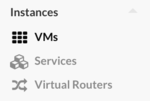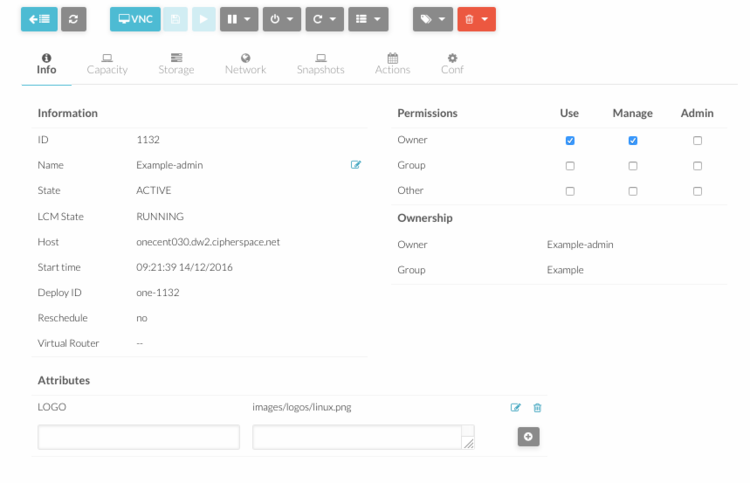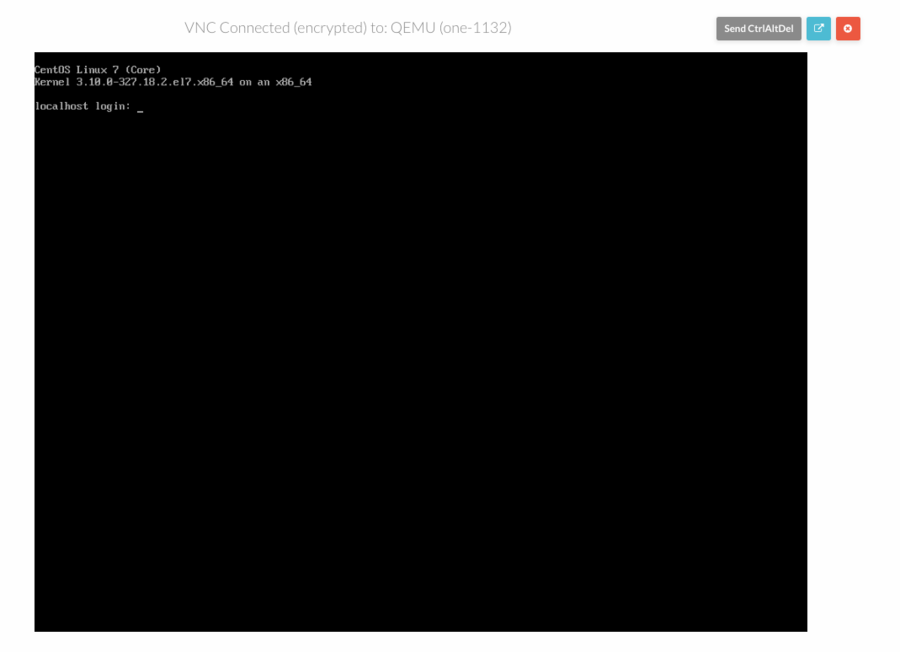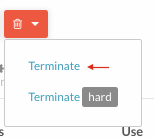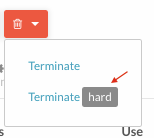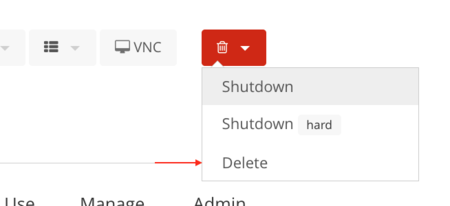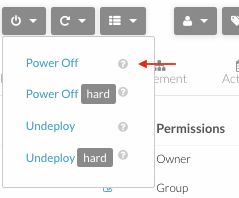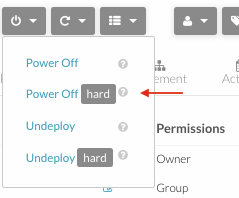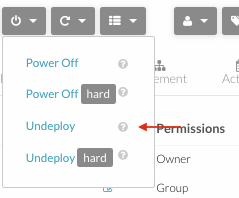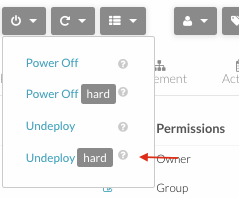How To Manage OpenNebula Virtual Machines
Look at running Virtual Machines
- Log into OpenNebula Sunstone.
- Go to “Virtual Resources” in the left menu and click on “Virtual Machines” in the drop down menu.
- A list of all instantiated virtual machines will apear. Some basic information is showed.
- Click on a virtual machine to see all its configuration.
Open VNC console
- Log into OpenNebula Sunstone.
- Go to “Virtual Resources” in the left menu and click on “Virtual Machines” in the drop down menu.
- Select the virtual machine you want to access and click on the "VNC" button.
Instantiate a Virtual Machine
- Go to “Virtual Resources” in the left menu and click on “Templates” in the drop down menu.
- Create or modify a template. This template will then be used to instantiate a virtual machine on which the operative system will be install.
- Click on the template just created and press "Instantiate" button to power on the virtual machine.
Terminate Virtual Machine Instances
You can terminate a running instance with the following operations:
- shutdown: Gracefully shuts down a running VM, sending the ACPI signal. Once the VM is shutdown the host is cleaned, and persistent and deferred-snapshot disk will be moved to the associated datastore. If after a given time the VM is still running (e.g. guest ignoring ACPI signals), OpenNebula will returned the VM to the RUNNING state.
- shutdown --hard: Same as above but the VM is immediately destroyed. Use this action instead of shutdown when the VM doesn’t have ACPI support.
If you need to terminate an instance in any state use:
- delete: The VM is immediately destroyed no matter its state. Hosts are cleaned as needed but no images are moved to the repository, leaving then in error. Think of delete as kill -9 for a process, an so it should be only used when the VM is not responding to other actions.
All the above operations free the resources used by the VM.
Shutdown
- Log into OpenNebula Sunstone.
- Go to “Virtual Resources” in the left menu and click on “Virtual Machines” in the drop down menu.
- Click on the virtual machine, press the red button with the bin and click "Shutdown".
- If more than one virtual machine need to be shut down, select each of them, press the red button with the bin and click "Shutdown".
Shutdown Hard
- Log into OpenNebula Sunstone.
- Go to “Virtual Resources” in the left menu and click on “Virtual Machines” in the drop down menu.
- Click on the virtual machine, press the red button with the bin and click "Shutdown hard".
- If more than one virtual machine need to be shut down, select each of them, press the red button with the bin and click "Shutdown Hard".
Delete
- Log into OpenNebula Sunstone.
- Go to “Virtual Resources” in the left menu and click on “Virtual Machines” in the drop down menu.
- Click on the virtual machine, press the red button with the bin and click "Delete".
- If more than one virtual machine need to be shut down, select each of them, press the red button with the bin and click "Delete".
Pause Virtual Machine Instances
There are two different ways to temporarily stop the execution of a VM: short and long term pauses. A short term pause keeps all the VM resources allocated to the hosts so its resume its operation in the same hosts quickly. Use the following actions:
- suspend: the VM state is saved in the running Host. When a suspended VM is resumed, it is immediately deployed in the same Host by restoring its saved state.
- poweroff: Gracefully powers off a running VM by sending the ACPI signal. It is similar to suspend but without saving the VM state. When the VM is resumed it will boot immediately in the same Host.
- poweroff --hard: Same as above but the VM is immediately powered off. Use this action when the VM doesn’t have ACPI support.
You can also plan a long term pause. The Host resources used by the VM are freed and the Host is cleaned. Any needed disk is saved in the system datastore. The following actions are useful if you want to preserve network and storage allocations (e.g. IPs, persistent disk images):
- undeploy: Gracefully shuts down a running VM, sending the ACPI signal. The Virtual Machine disks are transferred back to the system datastore. When an undeployed VM is resumed, it is be moved to the pending state, and the scheduler will choose where to re-deploy it.
- undeploy --hard: Same as above but the running VM is immediately destroyed.
- stop: Same as undeploy but also the VM state is saved to later resume it.
When the VM is successfully paused you can resume its execution with:
- resume: Resumes the execution of VMs in the stopped, suspended, undeployed and poweroff states.
Suspend
- Log into OpenNebula Sunstone.
- Go to “Virtual Resources” in the left menu and click “Virtual Machines” in the drop down menu.
- Click on the virtual machine, press the hold button and click "Suspend".
- If more than one virtual machine need to be suspended, select each of them, press the hold button and click "Suspend".
Poweroff
- Log into OpenNebula Sunstone.
- Go to “Virtual Resources” in the left menu and click “Virtual Machines” in the drop down menu.
- Click on the virtual machine, press the hold button and click "Poweroff".
- If more than one virtual machine need to be suspended, select each of them, press the hold button and click "Poweroff".
Poweroff Hard
- Log into OpenNebula Sunstone.
- Go to “Virtual Resources” in the left menu and click “Virtual Machines” in the drop down menu.
- Click on the virtual machine, press the hold button and click "Poweroff Hard".
- If more than one virtual machine need to be suspended, select each of them, press the hold button and click "Poweroff Hard".
Undeploy
- Log into OpenNebula Sunstone.
- Go to “Virtual Resources” in the left menu and click “Virtual Machines” in the drop down menu.
- Click on the virtual machine, press the stop button and click "Undeploy".
- If more than one virtual machine need to be suspended, select each of them, press the stop button and click "Undeploy".
Undeploy Hard
- Log into OpenNebula Sunstone.
- Go to “Virtual Resources” in the left menu and click “Virtual Machines” in the drop down menu.
- Click on the virtual machine, press the stop button and click "Undeploy Hard".
- If more than one virtual machine need to be suspended, select each of them, press the stop button and click "Undeploy Hard".
Stop
- Log into OpenNebula Sunstone.
- Go to “Virtual Resources” in the left menu and click “Virtual Machines” in the drop down menu.
- Click on the virtual machine, press the stop button and click "Stop".
- If more than one virtual machine need to be suspended, select each of them, press the stop button and click "Stop".
